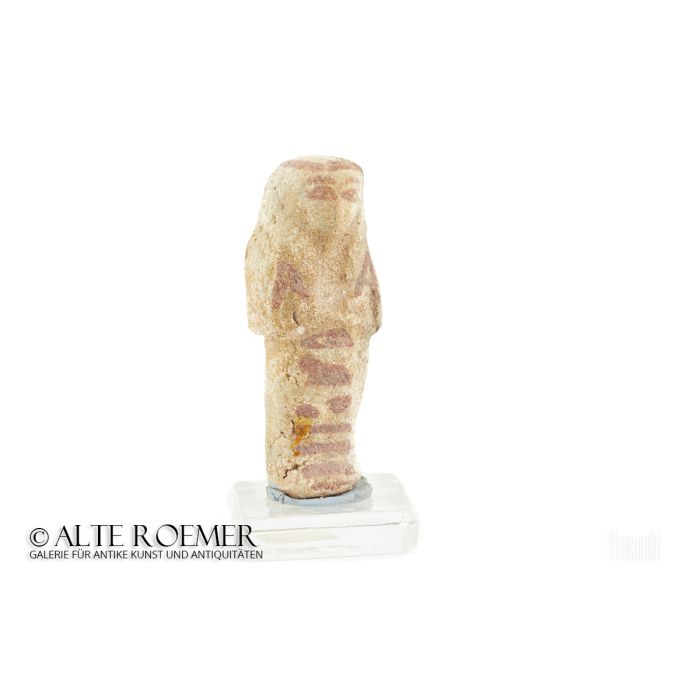Ushabti for Henut-tawy
Price: on request
Sold
Object number
AR2209
| Object: |
Egyptian ushabti for Henut-tawy
|
| Material: |
Mint green faience with black paint.
|
| Period: |
22nd dynasty, c. 946 BC to 834 BC. Third Intermediate Period of ancient Egypt. |
| Description: |
Egyptian funerary statuette with a mummy shaped body. Details are summarily modelled, arms are crossed in front of the chest. Further details are painted in black. The ushabti wears a tripartite wig secured by a fillet with rear ties (seshed), agricultural implement in each hand, a seed basket on the back, eyes emphasized with black. A vertical column of hieroglyphs on the front reading as follows. wcjr ¡nwt-tAwj mAa(t)-xrw, The Osiris, Henut-tawy, justified the name Henut-tawy (also spelled Henut-taui) means "mistress of the two countries". The funerary statuettes of this owner, Henut-tawy, were found in a tomb in the northern part of Abydos. |
| Background: |
In Ancient Egypt, a tradition of equipping the graves of the deceased with small funerary figurines gradually became established. The figurines were made of clay, stone, wood or metal, some were covered with faience. They were named with the ancient Egyptian word for "answerer". Transcriptions for this are ushabti, shabti or shawabti. Most commonly used and apparently popular were terracotta ushabtis covered with a fine greenish or blue faience. They were usually 10cm to 20cm tall. Those who could afford it had the ushabtis elaborately engraved or simply painted. The fine engravings of many pieces survived until today. Paint suffered more from the ravages of time, but fortunately some painted figures too have been preserved. The majority of the ushabtis found shows strong erosion and can only be recognized as such by their outlines. Or they were already that basic in their appearence when made in order to cut costs. Ushabtis have been resting with the deceased since the Middle Kingdom of Ancient Egypt around the beginning of the 2nd millennium BC. The earliest known figurines date from the 11th Dynasty. It seems they represented the dead initially, but their function changed until the New Kingdom. At that time the ushabti were to serve as workers in the afterlife, standing in for the deceased, so that he or she was freed from hard physical labour (6th chapter of the Book of the Dead). With this change in purpose it made sense to add more ushabtis to the grave increasing the labour force. This resulted in up to 365 ushabtis per tomb, e.g. for Tut-Anch-Amun - one "answerer" for each day of the solar year. Either the figures were placed directly in the grave or else richly painted or otherwise decorated vessels were used for storage, the best known type being the so-called wooden ushabti boxes. |
| Dimensions: |
101mm height, 41mm width.
|
| Condition: |
Very good condition. Fully intact without restorations. Surface slightly worn, but black paint still visible in most parts. Sticker from Davies Antiques reading "19th Dyn 71A" and older sticker once at the rear side of the ushabti reading "HENT-TAUI".
|
| Provenance: |
Acquired by us in 2017 from the private posession of M. Voos, Germany. Inherited by M. Voos from the German private collection H. Herbst. Acquired 19. Juli 1975 at Davies Antiques, London for the Herbst collection and brought to Germany (a copy of the original invoice is available). Two ushabtis for the same owner have been donated to the Manchester Museum in 1900, another one was donated to the Penn Museum by the Egypt Exploration Fund in the same year, further specimen found their way into museum collections in the following years. This leads us to conclude that this ushabti has been excavated in Abydos in 1900 or earlier, together with the other statuettes of the same owner. |
| References: |
Cf. G. Janes, The Shabti Collections 5, Manchester Museum, p. 259, no. 143 (2 specimen). Janes mentions 15 further figurines for this owner in various museums. Cf. an additional example at the Penn Museum, object no. E6658. |
| Literature: |
A good introduction and overview on Egyptian ushabtis in just one volume is given by Glenn Janes in Shabtis: A Private View - Ancient Egyptian Funerary Statuettes in European Private Collections.
|
| Authenticity: |
We unconditionally guarantee the authenticity of every artefact, all items are subject to our lifetime return policy on authenticity.
|


